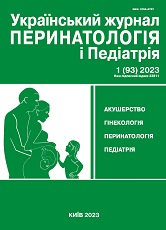Vascular factors and their role in the development of obstetric and perinatal complications in women with hepatitis B virus
DOI:
https://doi.org/10.15574/PP.2023.93.69Keywords:
women, pregnancy, viral hepatitis B, obstetric complications, perinatal complications, hemostasis system, endothelial dysfunctionAbstract
Purpose - to assess the role of vascular factors in the development of obstetric and perinatal complications in women with hepatitis B virus (HBV).
Materials and methods. The serum parameters of peripheral venous blood were studied in 86 pregnant women with HBV (the main group, which was divided into 2 subgroups: HBV1 - 38 women with obstetric and perinatal complications; HBV2 - 48 pregnant women without significant gestational complications) and in 50 women without infectious liver disease (the control group). The state of the platelet and coagulation links of the haemostasis system and the main indicators of endothelial function (nitric oxide and endothelin-1) were determined.
Results. In the vascular platelet system of pregnant women with HBV, a relative decrease in the number of platelets with an increase in their aggregation capacity and von Willebrand factor concentration was found, in the coagulation system - a decrease in fibrinogen with a slight decrease in the prothrombin index, recalcification time, international normalized ratio and an increase in activated partial thromboplastin time. The detected changes are even more pronounced in women with obstetric and perinatal complications (HBV1 subgroup): against the background of relative thrombocytopenia, the indicators of anisocytosis increase and the aggregation ability of platelets, the level of D-dimer and von Willebrand factor increase significantly. Endothelial dysfunction was found in women of the HBV1 subgroup (a decrease in the concentration of nitric oxide with an increase in endothelin-1).
Conclusions. The state of the haemostatic system in pregnant women with HBV can be characterized as an unstable equilibrium, which can be easily disturbed by various exo- and endogenous factors, which is observed in women with obstetric and perinatal complications and is manifested by prothrombotic changes. Established endothelial dysfunction in pregnant women with HBV is a leading link in the pathogenesis of obstetric and perinatal complications in this category of patients.
The research was carried out in accordance with the principles of the Helsinki Declaration. The study protocol was approved by the Local Ethics Committee of the participating institution. The informed consent of the patient was obtained for conducting the studies.
No conflict of interests was declared by the authors.
References
Campbell LA, Rosenfeld ME. (2015, Jul). Infection and Atherosclerosis Development. Arch Med Res. 46 (5): 339-350. Epub 2015 May 21. https://doi.org/10.1016/j.arcmed.2015.05.006; PMid:26004263 PMCid:PMC4524506
Cyr AR, Huckaby LV, Shiva SS, Zuckerbraun BS. (2020, Apr). Nitric Oxide and Endothelial Dysfunction. Crit Care Clin. 36 (2): 307-321. https://doi.org/10.1016/j.ccc.2019.12.009; PMid:32172815 PMCid:PMC9015729
Darmadi D, Ruslie RH. (2020, Aug 1). Endothelin-1 level as a predictor of hepatopulmonary syndrome in liver cirrhosis. Med Glas (Zenica). 17 (2): 389-394. doi: 10.17392/1177-20. PMID: 32567294.
Fox BM, Becker BK, Loria AS, Hyndman KA, Jin C, Clark H et al. (2018, Feb 16). Acute Pressor Response to Psychosocial Stress Is Dependent on Endothelium-Derived Endothelin-1. J Am Heart Assoc. 7 (4): e007863. https://doi.org/10.1161/JAHA.117.007863; PMid:29453306 PMCid:PMC5850198
Fujiwara RT, Bueno LL. (2022, Jul). Nitric oxide contributes to liver inflammation and parasitic burden control in Ascaris suum infection. Exp Parasitol. 238: 108267. Epub 2022 May 10. https://doi.org/10.1016/j.exppara.2022.108267; PMid:35550886
Jenkins HN, Rivera-Gonzalez O, Gibert Y, Speed JS. (2020, Dec). Endothelin-1 in the pathophysiology of obesity and insulin resistance. Obes Rev. 21 (12): e13086. Epub 2020 Jul 6. https://doi.org/10.1111/obr.13086; PMid:32627269 PMCid:PMC7669671
Riveiro-Barciela M, Marcos-Fosch C, Martinez-Valle F, Bronte F, Orozco O, Sanz-Pérez I et al. (2021, Aug 14). Naïve hepatitis B e antigen-negative chronic hepatitis B patients are at risk of carotid atherosclerosis: A prospective study. World J Gastroenterol. 27 (30): 5112-5125. https://doi.org/10.3748/wjg.v27.i30.5112; PMid:34497439 PMCid:PMC8384736
Saleh L, Verdonk K, Visser W, van den Meiracker AH, Danser AH. (2016, Oct). The emerging role of endothelin-1 in the pathogenesis of pre-eclampsia. Ther Adv Cardiovasc Dis. 10 (5): 282-293. Epub 2016 Jan 10. https://doi.org/10.1177/1753944715624853; PMid:26755746 PMCid:PMC5933567
Scharf RE. (2021, Apr 6). Thrombocytopenia and Hemostatic Changes in Acute and Chronic Liver Disease: Pathophysiology, Clinical and Laboratory Features, and Management. J Clin Med. 10 (7): 1530. https://doi.org/10.3390/jcm10071530; PMid:33917431 PMCid:PMC8038677
Stravitz RT, Bowling R, Bradford RL, Key NS, Glover S, Thacker LR, Gabriel DA. (2013). Role of procoagulant microparticles in mediating complications and outcome of acute liver injury/acute liver failure. Hepatology. 58: 304-313. https://doi.org/10.1002/hep.26307; PMid:23389887 PMCid:PMC5571831
Stravitz RT, Lisman T. (2015). Rebalanced Hemostasis in Patients with Acute Liver Failure. Semin. Thromb. Hemost. 41: 468-473. https://doi.org/10.1055/s-0035-1550430; PMid:26049071
Tripodi A. (2015). Liver disease and hemostatic (dys)function. Semin. Thromb. Hemost. 41: 462-467. https://doi.org/10.1055/s-0035-1550440; PMid:26080306
Downloads
Published
Issue
Section
License
Copyright (c) 2023 Ukrainian Journal of Perinatology and Pediatrics

This work is licensed under a Creative Commons Attribution-NonCommercial 4.0 International License.
The policy of the Journal “Ukrainian Journal of Perinatology and Pediatrics” is compatible with the vast majority of funders' of open access and self-archiving policies. The journal provides immediate open access route being convinced that everyone – not only scientists - can benefit from research results, and publishes articles exclusively under open access distribution, with a Creative Commons Attribution-Noncommercial 4.0 international license(СС BY-NC).
Authors transfer the copyright to the Journal “MODERN PEDIATRICS. UKRAINE” when the manuscript is accepted for publication. Authors declare that this manuscript has not been published nor is under simultaneous consideration for publication elsewhere. After publication, the articles become freely available on-line to the public.
Readers have the right to use, distribute, and reproduce articles in any medium, provided the articles and the journal are properly cited.
The use of published materials for commercial purposes is strongly prohibited.

